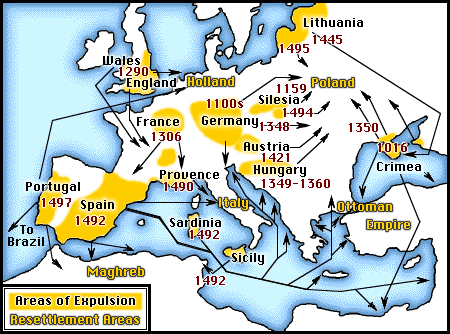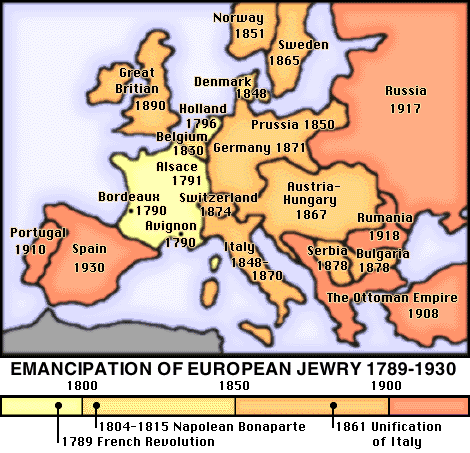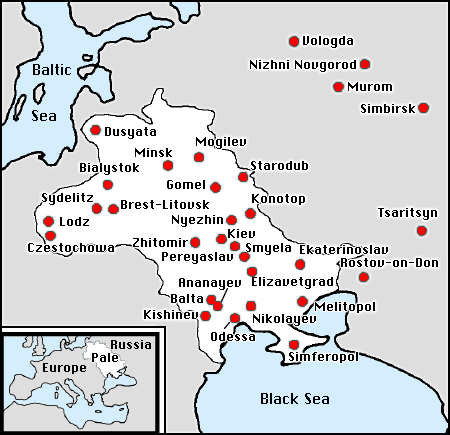The History of Eastern European Jews
with implication on the 'Turkel Tribe' genealogy.
| Based on several sources; see references
Jewish massive settlement in Middle and Eastern Europe has been recorded since the end of the 11th century. The first arriving Jews were merchants (dealing between east and the west) who were referred to as Radhanites. They were fluent in many languages, including Arabic, Persian, Greek, Spanish, "Franklish" and "Slav". One of them was Ibrahim Ibn Yacub, who authored the first known extensive article about Poland, took a journey from his hometown - Toledo - in (Moslem) Spain to the Holy (Christian) Roman Empire in 965 or 966 and then he went to the Slavonic countries. 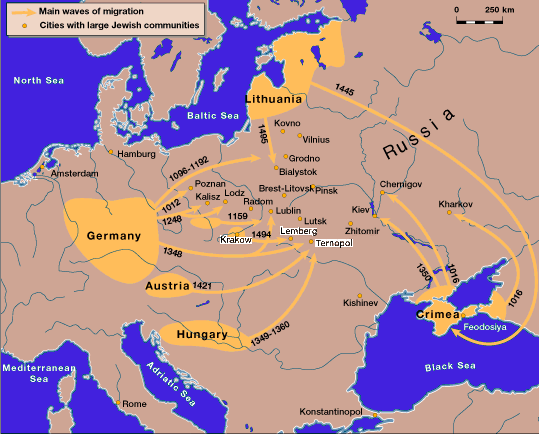 At the end of feudal disintegration in Central and Eastern Europe (occured in the 13th and 14th centuries) the rulers encouraged Jewish immigration. In the 14th and 15th centuries the Jews were mainly middlemen in trade between Poland, Hungary, Turkey and the Italian colonies on the Black Sea. Jewish immigrants headed east to Poland during the reign of Casimir the Great, who encouraged Jewish settlement by extending royal protection to them. One of the first mentions about Jewish settlements was in Lwow about 1356. Other places are also mentioned in the second half of the 14th century. In the 15th century Jews appeared in many cities in Great Poland, Little Poland, Kuyavia, Pomerania and Red Ruthenia. In the 1450's Polish towns gave shelter to Jewish refugees from Silesia which was then ruled by the Habsburgs.
In 1495 Jews were ordered out of the center of Krakow and allowed to settle in the "Jewish town" of Kazimierz. In the same year, Alexander Jagiellon, following the example of Spanish rulers, banished the Jews from Lithuania. For several years they took shelter in Poland until they were allowed back to the Grand Duchy of Lithuania in 1503. At that time Jews lived in about 85 towns in Poland. Their total number was around 18,000 in Poland and 6,000 in Lithuania, only 0.6 per cent of the total population of these two countries. In the 16th and the first half of the 17th Jewish population grew consierably, up to 500,000 Jews in Poland, about five per cent of the total population of Poland and the Grand Duchy of Lithuania. New arrivals were due to "Sephardic" Jews, who had been driven away from Spain and Portugal. There is a reason to believe (see the 17th century legend) that the Turkels are "Sephardic" Jews, who arrvied from Spain/Potrugal to Poland via Turkey. Still we are not sure when exactly they arrived to the Eastern and Central Europe. In the 16th and 17th centuries the Jews were required to defend the towns they lived in either by service or by monetary contributions. Sometimes Jews fought on both sides, leading to family tragedies. During Poland's wars with Sweden (1655-60), Russia (1654-67) and Turkey (1667-99) Jews provided recruits and participated in the city's defense. There are war stories about relevant places such as Buczacz, Trembowla (see also here) and Lwow (see also here). In 1648 the Cossack uprising under Chmielnicki broke up. There was a breakthrough in the history of both the "Commonwealth" and Polish Jewry. The country was plunged into economic crisis due to the wars against the Ukraine, Russia, Sweden, Turkey and the Tartars, which Poland fought almost uninterruptedly between 1648 and 1717. As a result of Chmielnicki's revolt and wars against the Ukraine and Russia Jewish communities in the areas occupied by enemy troops were completely wiped out. Some Jews were murdered, some emigrated to central Poland and the rest left for Western Europe. The sharp drop of the Jewish population is estimated as to be 100,000-125,000 out of 500,000. Folowing 1717 there was a rapid growth in the number of the Jewish population, up to about 750,000 Jews in 1766 (ref. tax census), which constituted 7% of the total population of Poland and the Grand Duchy of Lithuania. About 29% of all Jews lived in ethnically Polish areas and 27% in regions with a predominantly Ukrainian population. The population census conducted in Poland in 1790-91 shows a further increase in the number of Jewish inhabitants, about 900,000.
The partition of Poland took place in 1772, among Russia, Prussia and Austria. 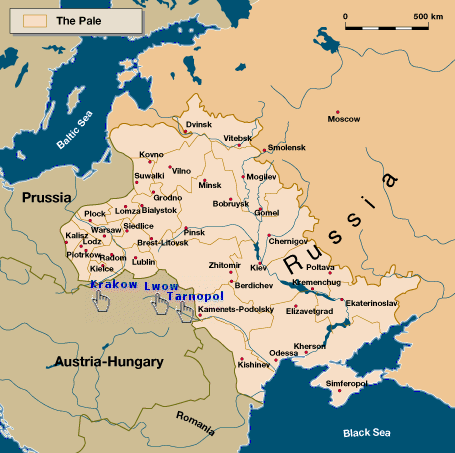 The Pale of Settlement fingers point to places Turkels settled on the left side of the pale It is important to elaborate that there were different regulations in the Prussian and Austrian partition zones. In the Prussian zone, according to the decree issued by Frederick II, the Jewish population was to be subordinated to the Prussian Jewish ordinance (General Judenreglement) of 17 April 1797. The right to permanent residence in towns was granted only to rich Jews and those engaged in trade. The poor Jews, the Bettel Juden, were ordered by Frederick II to be expelled from the country, and the Jewish self-government organizations were exclusively limited to religious affairs. In the Austrian partition zone the attitude towards the Jewish question went through two stages.
The Imperial Russian Empire also embraced Jews.
Obviously many Jews refused to join the Tsarist Army, and this may conform with the 18th century legend about the origin of the surname Turkel. Jews employed many methods to avoid induction including the use of false documents. Many young men simply ran away from their communities when their draft date approached. Jews were required to register all births, marriages etc. in the Synagogue to which they were assigned. After 1857 the records were kept by Crown Rabbis who were usually not the spiritual leaders of the respective communities.
As late as the middle of the 19th century, Russian Government officials complained about the frequent change of family names among Russian Jews who lived in different communities under different surnames. Basic changes in the situation of Galician Jewry took place after 1848. Some Jews were quite active in the revolutionary movement of the period, which resulted in a Polish-Jewish reconciliation and Jewish emancipation. In the years following 1859 the Austrian authorities began to gradually repeal legal restrictions. In 1867-68 all citizens, Jews included, were finally made equal in the eyes of the law.
Return to Bad Times The difficult economic situation in Galicia caused violent actions (pogroms) against Jews, who due to the situation chose to emigrate elsewhere. Generally, Jews from Galicia sought work in other countries of the Austro-Hungarian Empire, sometimes in Vienna, and also in Hungary and the Balkan countries. Between 1881 and 1900 about 150,000 left elsewhere, and between 1900 and 1914 about 175,000 Jews from Galicia left for the United States of America. At the same time various Zionist movements emerged and a few of our Turkel folks made Alyiah to the Holy Land aka Eretz Israel. Like other Jews many members of the 'Turkel Tribe' immigrated to the USA. At ths end of ths First World War Galicia was annexed to Poland. The Jews expected to have right for autonomy but the Polish government never yielded. Moreover the situation of the Jews was dramatically deteriorated. Their rights were quite limited compared to other nationals. Following 1924 the immigration to the USA was stalled. Jews looked for alternative ways to get out of Poland, in particular to Palestine, but the British Mandate denied entry of many. The fate of most of the Jews were doomed in the Holocaust during the Second World War. About Six Million Jews, half of them (3 millions) in Poland and about 450,000 Galician Jews were murdered. More than 90% of the Turkel families (those who remained in Poland/Galicia) lost their lives. Here we return to our main quest to find out the common ancestors of the 'Turkel Tribe'. We pursuit genealogy, including legends and stories of these East European Jews. References for further reading:

The origins of "our" Turkel family |
||||||||||
┬® 1999-2023 'T├╝rkel Tribe' Sign or View guestbook | Web-Site Directory

